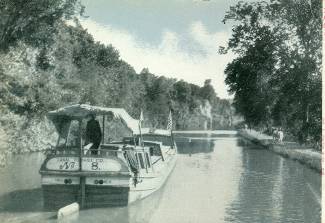Collection Name
About
Canal's history rewritten
Researchers say blacks left out
By TERRY HEADLEE
Staff Writer
Even though it's been 70 some years, J.P. Mose can still vividly remember watching Henry Williams steer his canal boat filled with coal down the winding Chesapeake and Ohio Canal.
"He was one of the finest men to ever walk on the towpath. He had a kind word for everybody," said Mose, 91, who worked on the waterway as a boatman in the years before it closed in 1924. He now lives in Beaver Creek.
Williams, who lived in Hancock, is listed in the records of the C&O Canal Co. as a boat captain and his name is mentioned in some past historical articles about the canal.
What isn't noted is that Williams was black.
In fact, there are no references to any blacks working on the canal in the interpretative information compiled for visitors by the U.S. National Park Service.
That will soon change, park officials said.
Three history professors from Coppin State College in Baltimore spent the summer documenting the names of blacks who in some way were involved in the operation of the canal. They've identified 32 so far.
The college is now preparing to embark on a five-year study to be funded by the park service that will document more names of blacks and to learn what their roles were on the 184-mile waterway.
The preliminary findings mean the interpretative history and literature handed out by the park service will have to someday be rewritten, said former C&O Canal National Historical Park Superintendent Richard Stanton.
Stanton said in an interview shortly before he retired Sept. 1 that Coppin officials had uncovered spine "astounding information."
"We're going to have to change the entire interpretation of the canal because we haven't included the role of blacks in the canal," Stanton said. "It's disturbing. Nowhere in the interpretation is the role of blacks mentioned in the canal's history and that's wrong."
Dr. Cynthia Neverdon-Morton of Coppin College said the college will officially kick off its five-year study with a press conference and reception Sept. 29 in Baltimore. By then, the researchers hope the project will have been approved by the Maryland Board of Regents.
Neverdon-Morton is one of three professors at the predominately black college spearheading the Study. The professors, who also include Dr. Bettye Gardner and Dr. Chester Gregory, received a $12,000 investigative grant from the park service earlier this summer to do some preliminary work.
Researchers spent six weeks poring through records and interviewing dozens of people. The information will be explored more fully during the five-year study that will first focus on Hagerstown, Hancock, Williamsport and Cumberland.
"Right now we can say without any hesitation that African Americans had a role in the canal based on census records, printed accounts and oral interviews," Neverdon-Morton said.
The idea for the research actually came from Stanton who had discovered through earlier research that blacks had operated boats on the Powtomack Canal at Great Falls, Va., which first opened in 1788.
Neverdon-Morton said Stanton approached the college last spring to see if officials there would be interested in doing a similar research project for the C&O Canal.
"We thought it was a great idea and we believe we can help in putting the role of African Americans on the canal into some type of historical perspective," she said. The study will also examine how the canal and blacks impacted the towns that the waterway passed by.
It also will be used to help clear up some unconfirmed stories.
"There is a myth that's circulated in a number of references that we've seen that said when boaters hired blacks for work, rather than paying them at the end of the trip, they would knock them over and drown them," Neverdon-Morton said.
She said she didn't know if it was true, but there are enough questions to warrant more investigation.
"That's an example of the things we want to flush out to find the historical truth," she said, adding that researchers may find examples of racism.
"But we feel you need to tell the complete story no matter what it is," she said. "That's what's underlining the study."
The researchers plan to publish a research book with photographs at the end of five years. The group will also periodically publish brochures on what they've been able to uncover.
As for Williams, Neverdon-Morton said researchers have been able to learn that he was a captain with the canal company and operated Boat No. 52.
"But the records don't indicate he was an African American," she said. "He wasn't omitted, but it was just assumed he was white like the rest of them."
Neverdon-Morton said she is saddened by the lack of recognition for blacks on the canal, but said there is no animosity.
"This study is not being done in anger because people would think it's reactionary, rather than scholarly in approach," she said. "We just want to add the missing dimension to the historical truth."
Reprinted with permission of the Herald-Mail Co. of Hagerstown, Md.
The Chesapeake and Ohio Canal National Historic Park has a listing of known canal workers. Only two of the captains are thought to be black, Captain Williams and Andrew Jenkins.
The image is from a postcard from the collection of Albert and Angela Feldstein.
